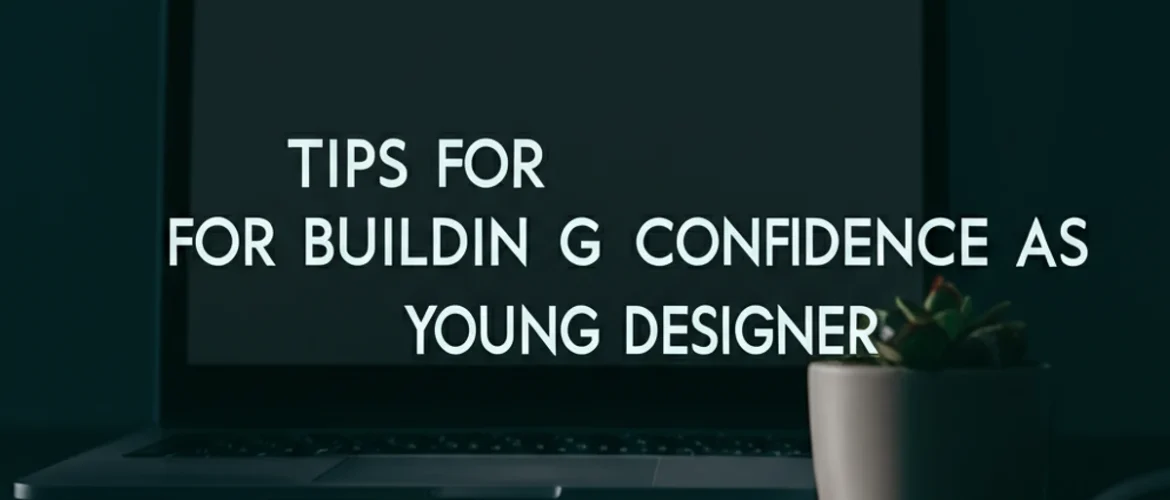Blog
Tips for Building Confidence as a Young Designer
- October 3, 2025
- Posted by: admin
- Category: ** Design

Designer ## Unlocking Your Dynamo Inner: A Young ‘s Guide to Unshakeable Confidence
Hello fellow creative! Remember that electrifying moment you decided to dive into headfirst world the of design? The thrill of imagining shaping and bringing ideas to life?It’s a powerful, exhilarating feeling.But if you’re anything like the aspiring s I’ve met (and certainly like my younger self ! ), that initial rush can sometimes be by shadowed a more unsettling emotion: doubt.
You might be standing at the precipice of an incredible career , armed with talent and ambition yet whispers of “Am I good enough?” or “Do I really belong here? ” echo in your mind.This feeling,often dubbed syndrome imposter is incredibly common among young creatives . The blank canvas of a new project, the daunting array of tools , the sheer volume of incredible work already out there – it can all feel overwhelming .
But here’s the secret: confidence isn’t something you’re born with; it’s something you build brick by thoughtful brick. It’s a muscle you strengthen a skill you hone, and a perspective you cultivate. This isn’t just about feeling good; it’s about unlocking your full creative potential and allowing your unique vision to shine brightly . Consider this your essential young guide to navigating those jitters early and cultivating genuine confidence in design.
So let’s embark on this journey together practical exploring empathetic design confidence tips that will help you transform self-doubt into a powerful wellspring of assurance.
—
Is My Vision Worth Sharing? Taming the Inner Critic
Every , from the seasoned veteran to the fresh graduate,grapples with the invisible, often harsh inner critic. This voice loves to remind you of perceived flaws, compares your raw early sketches to polished professional work , and whispers that your ideas aren’t original or impactful enough .For a young this can paralyzing be stopping brilliant concepts before they even reach the screen or page.
Remember that you time hesitated to show a project because it didn’t feel “perfect” ? I certainly do .Early in my career I designed a logo for a local cafe that I was intensely proud of but then I saw a stunning, minimalist mark by a renowned agency and my work suddenly felt childish ,unrefined.I almost scrapped it.But here’s the thing: your unique perspective your individual creative fingerprint is your superpower.No one else sees the world exactly as you do and that distinct lens is precisely what makes your design valuable .Acknowledge the critic,don but’t let it drive the bus. Separate your self-worth from your work’s perceived perfection and understand that sharing is part of the learning journey.
—
How Do I Really Know My Stuff? The Power of Profound Practice
of One the most potent antidotes to self-doubt is competence.you When genuinely understand principles the ,tools and processes of design a quiet assurance begins to bloom within you.This isn’t about knowing everything – that’s impossible! – but about building a solid foundation of expertise and committing to continuous learning.Think of it as steadily accumulating design superpowers.
Dive deep into the fundamentals: typography color theory layout, user experience principles.Don’t just follow tutorials; understand the why behind each step. Why is this typeface legible? Why does this color palette evoke this emotion? Why is this particular user flow intuitive? The more you understand the underlying mechanics the less you’ll feel like you’re simply guessing.Practice deliberately hypothetical tackle briefs recreate existing designs to deconstruct them and critically analyze your own work . The more you hone your craft the more natural and automatic your creative decisions become will leading to a profound sense of confidence in design .
—
Why Does Feedback Feel So Personal?Cultivating a Critique-Proof Mindset
Ah, feedback.It’s the lifeblood of growth in design yet for many especially young s it can feel like a direct assault on their creative soul .You pour hours, passion and personal vision into a project, only for someone to point out its flaws. It’s easy to take it personally to feel discouraged,even or defensive.
I once presented a website concept a to client, brimming with only excitement them for dissect to it line by line tearing apart elements I thought were brilliant. My immediate reaction was a sinking a feeling sense of failure. But here’s the shift: successful s learn to separate the work from their self-worth. View critique not as an attack,but as collaborative a tool for improvement. Ask clarifying questions: “What specific aspect isn’t working you for and why? ” “What outcome are you hoping to achieve with this change ?” Seek out constructive feedback mentors from and peers viewing it as gold nuggets of insight that will help you refine your craft.This skill of receiving acting and on feedback is one of the vital most design confidence you tips’ll ever receive.
—
Where Do I Even Begin to Show My Work? Unveiling Your Narrative Unique
It’s one thing to create great work; it’s another to put it out into the world . Many young s struggle with how and when to build portfolio a and share their unique voice.The fear of judgment the perceived lack of “professional” projects, or simply not knowing where to start can be paralyzing.
Your portfolio isn’t just a collection of pretty pictures; it’s your visual resume, your design story , and your personal brand statement . Don’t wait for the “perfect” client project. Start with passion projects fictional briefs, or even re-designs of existing brands you admire. Curate , don’t just collect. Show your process your thinking , the and problems you solved not just the final gleaming outcome. Remember the journey is often as compelling as the destination. Share your work on platforms like Behance, Dribbble or your own website . Engage with other s, join online communities , and attend local meetups. Every piece you share every connection you make, is a step towards building visibility and solidifying your confidence in design.
—
What if I Mess Up? Embracing the Art of the ‘Happy Accident’
Fear of failure is a powerful inhibitor of creativity and confidence .As a young you might worry that mistake a could ruin a project,damage your reputation or confirm your deepest insecurities.This anxiety can lead to playing it safe avoiding risks and ultimately stifling innovation .
Let me tell you a secret: every up messes. A lot .I’ve launched projects with typos chosen color palettes that clashed once live, and presented concepts that completely missed the mark. But here’s the magic: failures aren’t endpoints; they’re launchpads. They’re invaluable lessons disguised as setbacks. Embrace experimentation. View “mistakes” as data points, as unexpected detours that can sometimes lead to even more brilliant solutions – the “happy accidents” that often define truly innovative design . Building resilience the ability to bounce back and learn from missteps, is absolutely for critical long-term design confidence tips. It teaches you that your worth isn’t tied to perfection, but to your persistence and your capacity for growth.
—
Building confidence as a young is a journey, a not destination .It’s a continuous process of learning , practicing accepting feedback,taking calculated risks,and celebrating small victories . Each time push you past doubt learn a new skill or bravely share your work, you add another brick to the foundation of your self-assurance.
You possess a unique spark, a creative vision that the world needs to see. Don’t let the whispers of insecurity dim that light. Lean into the learning , embrace the challenges, and remember that every single you admire started exactly where you are now – with a a dream dash of fear and a burning desire to create.Go forth,design bravely , and let your confidence in design soar !
What’s one step you’re going to take this week to build your design confidence? Share your thoughts in the comments below!
